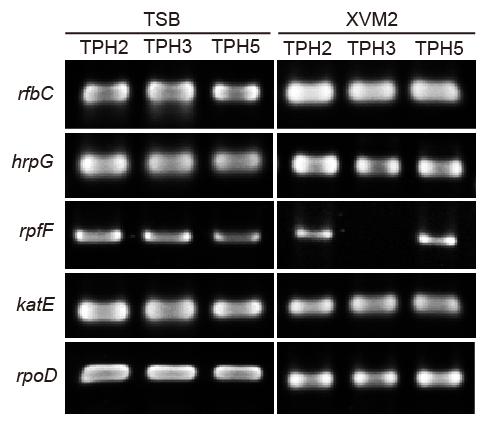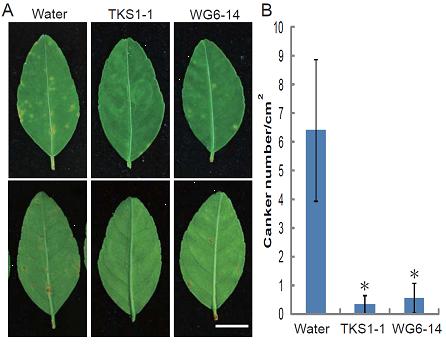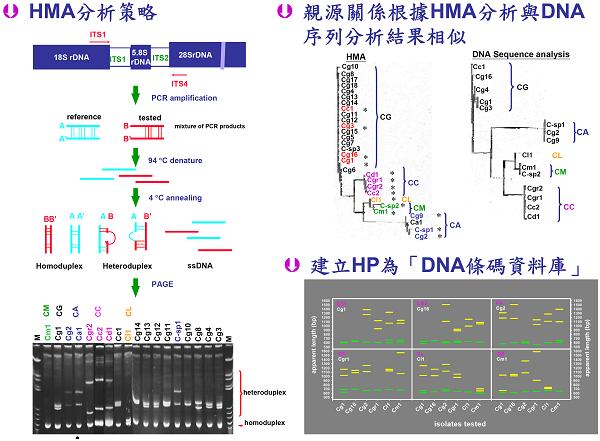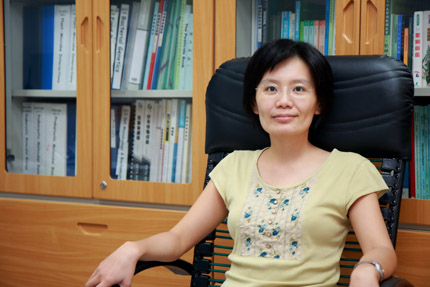
Tzu-Pi Huang Professor
Ph. D., 2007, Department of Food Science (Food Microbiology and Safety Option), University of Wisconsin-Madison
M.S., 1999, Department of Plant Pathology, National Chung-Hsing University
B.S., 1997, Department of Plant Pathology, National Chung-Hsing University
Professor, Department of Plant Pathology, National Chung-Hsing University (2021.8 to present)
Associate Professor, Department of Plant Pathology, National Chung-Hsing University (2013.8 to 2021.7)
Assistant Professor, Department of Plant Pathology, National Chung-Hsing University (2007.8-2013.8)
Master’s and Ph. D Degree Programs’ Chair, Plant Health Care Program / Specialty Crops and Metabolomics Program/ Biological and Sustainable Technology Program/ International Precision Agribusiness Development Program, Academy of Circular Economy National Chung-Hsing University, Taiwan (2022.5-present)
Director, Pesticide Residue Analysis Center, National Chung Hsing University (2017.2 to 2022.7)
Laboratory head and Report Signatory, Pesticide Residue Analysis Center, National Chung Hsing University (2010.1 to 2022.7)
Advisory Board Committee, Asia Pacific Biofertilizer and Biopesticide Information Platform (2022.7 to present)
Chief Executive Officer, Plant Protection Science and Technology Foundation (2015.4 to 2021.3)
Associate Editor of Phytobiomes Journal, American Phytopathological Society, USA (2018.10 to present)
Editorial Board of Journal of Plant Medicine (2016.07 to present)
Editorial Board of Plant Pathology Bulletin (2012.07-2016.06)
Treasurer, Taiwan Phytopathological Society (2012.07-2016.06)
Postdoctoral Fellow, Department of Food Microbiology and Toxicology, University of Wisconsin-Madison, USA
Phone (Lab): +886-4-22840780 ext. 340
Phone (Office): +886-4-22840780 ext. 379 or +886-4-22859750
E-mail:tphuang@nchu.edu.tw
Office:Agricultural & Environmental Science Building 6 Floor, Rm# 6C08
Microbial biofilm, Microbial communication, Biological control, Pesticides
- Microbial cell to cell signaling and biofilm formation
- Biological control and integrated pest management
- Analysis of pesticide residues and metabolites produces by microbes
1. Microbial cell to cell signaling and biofilm formation
Bacteria communicate to each other by secreting and sensing small molecules in response to cell density and coordinate their physiological processes. The known physiological processes include biofilm formation, motility, production of antimicrobial agents and expression of virulence factors. This phenomenon is known as “quorum sensing” and is crucial for a number of bacteria to successfully develop pathogenic, antagonistic or symbiotic relationships with their hosts. Thus, quorum sensing circuits represent an attractive target for the design of strategies to prevent bofilm formation, manipulate production of antimicrobial agents and attenuate infection.
Research focuses of my group are on understanding microbial cell-to-cell signaling, and addressing the roles of the signaling in its physiological processes particular those for survival, pathogenesis and as biocontrol agents. Our main study organisms are Xanthomonas species, Bacillus subtilis group and Streptomyces species. The long term goal is to design strategies by interference of the signaling system against infections caused by microbes or to manipulate mechanisms for the management of plant disease by microbial agents.
2. Population diversity and integrated pest management
The increase population of pesticide resistant pests in the field is partly due to long term exposure to and improper use of chemical pesticides. Integrated pest management (IPM) is an integrated approach of crop management. This approach with a main goal of significantly reducing or eliminating the use of pesticides while at the same time managing pest populations at an acceptable level, reducing human and environmental exposure to hazardous chemicals, and maintaining the balance of ecosystem. Biological control of plant pathogens by the purposeful utilization and introduction of antagonistic and live organisms in the field is emerging. Bacillus species and Streoptomyces species with properties of forming spores and production of varieties of antibiotics, enzymes, secondary metabolites, promoting animal/ plant growth or immune system are commonly used and investigated for the application in agriculture and industry. For control of bacterial diseases, there are only few suggested chemical pesticides available. The suggested pesticides include anitibiotics and copper compounds, while these compounds are known of high risk in causing pesticide resistance and environmental pollution. In addition, there is no known biocontol agent available. In our project, native microorganisms such as Bacillus subtilis group and Streptomyces species with antagonistic activity against X. axonopodis pv. citri, X. axonopodis pv. mangiferaindicae, X. oryzae pv. oryzae, anthracnose fungi and Botrytis species etc. will be screened and assessed. The potential application of native microorganisms as biocontrol agents for bacterial and fungal diseases will be examined. Information gained from this study will provide strategies by using biocontrol agents in disease management. In addition, fungicides and insecticides comparible with microorganism pesticides will be evaluated to serve as the basis for the application of abiotic and biotic pesticides in combination. In the long term, problems of pesticide residue in fruits and pesticide resistance will be resolved. The genetic identity based on rDNA sequences of Bacillus and Streptomyces strains from Taiwan and worldwide will be compared and the DNA fingerprints will be assayed for future patent and commercial use of the strains. Information gained from this study will provide strategies in integrated pest management of important plant diseases.
3. Diagnosis and identification of fungal pathogen
Colletotrichum species are the causative agents of anthracnose on various important crops and the most notorious post-harvest pathogens greatly deteriorating the quality and shelf-life of agricultural products. Identification of Colletotrichum spp. by morphotaxonomic criteria is often frustrating and time consuming because these pathogens have wide host range, vary in morphological characteristics by environmental factors, and cross infect on one host. To cope with increasing demand of identification of this fungal pathogen, the application of heteroduplex mobility assay of ITS regions as a biochemical tool is explored. The aims of this project are to 1) survey and identify the Colletotrichum spp. that caused anthracnose disease in important exporting fruits by heteroduplex mobility assay of ITS regions; 2) verify the potential application of heteroduplex mobility assay in diagnosis and identification of Colletotrichum spp.; 3) investigate the application of heteroduplex pattern as an aid in identification. Information gained from this project will advance our knowledge in the species and genetic diversity of the Colletotrichum spp. in Taiwan. The heteroduplex pattern and reference isolates established in this study will provide a sensitive and inexpensive methodology in identification of large number of isolates. This methodology will be applicable in pathogen diagnosis and quarantine.
1. Microbial cell to cell signaling and biofilm formation
Phyllospere biofilm of antagonistic Bacillus species and its application in control of citrus canker disease
Citrus bacteria canker caused by Xanthomonas axonopodis pv. citri is the most devastating bacterial disease of citrus plants worldwide. Biofilm formation has been indicated to be important for various bacteria to successfully develop pathogenic relationships with their host. Thus strategies for disease control are developed by interference of biofilm formation. The objectives of this study are to understand the molecular mechanisms of biofilm formation on leaf surfaces of citrus plants by X. axonopodis pv. citri and the potential link to pathogenicity, and to investigate the efficacy of using antagonistic bacilli to interfere the biofilm formation by X. axonopodis pv. citri on surfaces of citrus leaves. To understand the mechanisms of biofilm formation by X. axonopodis pv. citri, the strain XW19was subjected to transposon mutagenesis. One mutant with mutation in a two-component response regulator and deficient in biofilm formation in polystyrene microplate was selected for further study. The two-component response regulator BfdR (for biofilm formation defective, regulator) mutant showed reduction in the development of biofilm and canker lesions as well as epiphytic growth on the leaf surfaces of citrus plants. BfdR was found to positively control the rpfF expression in XVM2 medium. The results indicated that biofilm formation and bacterial survival of X. axonopodis pv. citri on the leaf surfaces of citrus plants are associated with bacterial virulence and are controlled by BfdR through regulation of rpfF, which is required for the biosynthesis of diffusible signal factor [Published in PLoS ONE (2013) 8(4):e62824)].Application of antagonistic bacilli on citrus leaves resulted in interference of biofilm formation by X. axonopodis pv. citri which may be a feasible way for the disease control of citrus bacterial canker [Published in PLoS ONE (2012) 7(7):e42124].
- A novel two-component response regulator links rpf with biofilm formation and virulence of Xanthomonas axonopodis citri
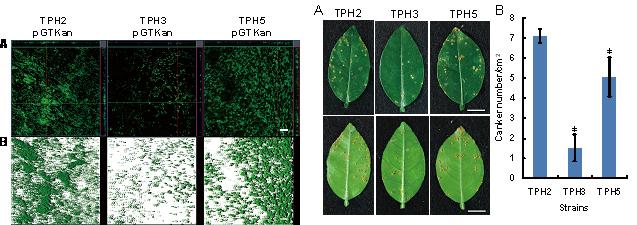
-
- The two-component response regulator BfdR in X. axonopodis pv. citri plays roles in biofilm formation, and virulence on leaf surfaces of citrus plants. (Publsihed in PLoS ONE (2013) 8(4):e62824)
- The two-component response regulator BfdR in X. axonopodis pv. citri plays roles in biofilm formation, and virulence on leaf surfaces of citrus plants. (Publsihed in PLoS ONE (2013) 8(4):e62824)
-
- BfdR positively controls the expression of rpfF in medium mimicking cytoplasmic fluids in planta.
- Biocontrol of citrus bacterial canker by antagonistic Bacillus species with indication of the interference of phyllosphere biofilms
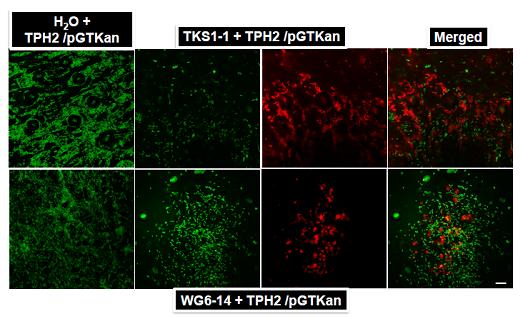
-
- The colonization and biofilm formation of citrus canker bacteria (Red fluorescence) on leaf surfaces of citrus plants were reduced by the treatment with strains of B. subtilis group (TKS1-1 & WG6-14 – Green fluorescence). (Published in PLoS ONE (2012) 7(7):e42124)
- The colonization and biofilm formation of citrus canker bacteria (Red fluorescence) on leaf surfaces of citrus plants were reduced by the treatment with strains of B. subtilis group (TKS1-1 & WG6-14 – Green fluorescence). (Published in PLoS ONE (2012) 7(7):e42124)
-
- The symptom development of citrus bacterial canker is attenuated by the treatment with B. subtilis TKS1-1 and B. amyloliquefaciens WG614. (Published in PLoS ONE (2012) 7(7):e42124)
2. Population diversity and integrated pest management
Citrus bacterial canker caused by Xanthomonas axonopodis pv. citri is a devastating disease resulting in significant crop losses in various citrus cultivars worldwide. A biocontrol agent has not been recommended for this disease. To explore the potential of native bacilli in Taiwan to control this disease, Bacillus species with a broad spectrum of antagonistic activity against various phytopathogens were isolated from plant potting mixes, organic compost and the rhizosphere soil. Seven strains TKS1-1, OF3-16, SP4-17, HSP1, WG6-14, TLB7-7, and WP8-12 showing superior antagonistic activity were chosen for biopesticide development. The genetic identity based on 16S rDNA sequences indicated that all seven native strains were close relatives of the B. subtilis group and appeared to be discrete from the B. cereus group. DNA polymorphisms in strains WG6-14, SP4-17, TKS1-1, and WP8-12, as revealed by repetitive sequence-based PCR with the BOXA1R primers were similar to each other, but different from those of the respective Bacillus type strains. Information gained from molecular typing of native strains would provide DNA fingerprints as an aid for patenting or commercializing the stains in the future [Published in PLoS ONE (2012) 7(7):e42124]. In addition, our previous study indicated that the application of a Bacillus strain TKS1-1 endospore formulation to the leaf surfaces of citrus reduced the incidence of citrus bacterial canker and could prevent development of the disease.
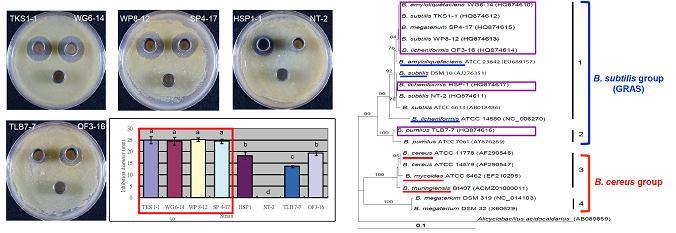
Bacillus strains SP4-17, WP8-12, WG6-14 and TKS1-1, which showed the greatest antagonistic activity, were members of the B. subtilis group recognized as GRAS bacteria.
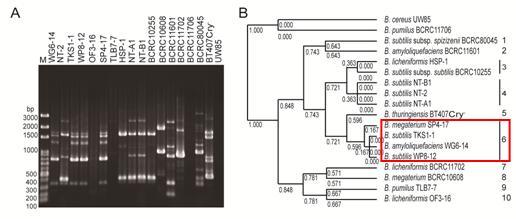
Strains SP4-17, TKS1-1, WG6-14 and WP8-12 showing the superior antagonistic activity against X. axonopodis pv. citri had the same BOXA1R-PCR fingerprint, which is different from their respective type strains.
3. Development of molecular techniques for diagnosis and identification of fungal Pathogen
Colletotrichum spp. are the causal agents of anthracnose on various important crops and the most notorious post-harvest pathogens greatly deteriorating the quality and shelf-life of agricultural products. Identification of Colletotrichum spp. by morphotaxonomic criteria is often frustrating and time consuming because these pathogens have wide host range, vary in morphological characteristics by environmental factors, and cross infect on one host. To cope with increasing demand of identification of this fungal pathogen, the application of heteroduplex mobility assay of ITS regions as a biochemical tool was explored. The ITS regions of tested Colletotrichum isolates including C. gloeosporioides, C. acutatum, C. musae, C. graminicola , C. capsici, C. dematium, C. lindemuthianum, and Colletotrichum sp., were PCR amplified using the universal primers ITS1 and ITS4. The data from HMA of ITS regions suggested that tested Colletotrichum isolates could be divided into 5 distinctive species groups. The correlation of DNA distance and relative heteroduplex motility from reference isolates was calculated. The calculated formula was used to deduce DNA distances of tested sequences from relative heteroduplex motility. Phylogenetic analysis of ITS regions based on DNA distance inferred from relative heteroduplex mobility showed that tested Colletotrichum isolates was classified into five groups, namely CG, CA, CC, CM, and CL which is the same as that from DNA sequences. Analysis of the heteroduplex pattern (HP) with reference isolates C. gloeosporioides Cg1, C. gloeosporioides Cg16, C. musae Cm1, C. gloeosporioides Cg2, C. graminicola Cgr1 and C. lindemuthianum Cl1 indicated that 29 Colletotrichum isolates could be divided into 6 distinctive species groups. Isolates of C. gloeosporioides could be divided into two subgroups CG1 and CG2. In conclusion, HMA and HP of ITS regions is a relative rapid and simple method for species-specific identification of Colletotrichum spp. Because the uniqueness of HP when assaying with DAN from reference isolates, we suggest that the HP of ITS regions may be use as “DNA barcodes” for the identification of anthracnose fungi [published in J. Phytopath. 158(1):46-55. & New Biotech. (2011) 28(1):72-78.].
Pesticides, Experiment in Pesticides, Pesticide Residues Analyses and Food Safety, Agricultural Pesticides-Pharmacology and Application, Agricultural Pesticide Prescriptions, Microbial Communication, Sustainable Agriculture and Ecology.
- Yun-Chien Wu, Chien-Wen Yu, Jo-Yu Chiu, Yu-Hsuan Chiang, Nobutaka Mitsuda, Xu-Chen Yen, Tzu-Pi Huang, Tzu-Fang Chang, Cen-Jie Yen, Woei-Jiun Guo. 2023. The AT-hook protein AHL29 promotes Bacillus subtilis colonization by suppressing SWEET2-mediated sugar retrieval in Arabidopsis roots. Plant Cell Environ (Published Online https://doi.org/10.1111/pce.1477)
- Bo-Lin Ho, Jhun-Chen Chen, Tzu-Pi Huang*, Su-Chiung Fang*. 2022. Protocorm-like-body extract of Phalaenopsis aphrodite combats watermelon fruit blotch disease. Plant Sci. 13:1054586. (doi: 10.3389/fpls.2022.1054586)
- Ting-Zhi Liao, Yu-Hsuan Chen, Jyh-Nong Tsai, Chieh Chao, Tzu-Pi Huang, Cheng-Fang Hong, Zong-Chi Wu, Isheng J. Tsai, Hsin-Han Lee, Ned B. Klopfenstein, Mee-Sook Kim, Jane Stewart, Ndeme Atibalentja, Fred E. Brooks, Philip G. Cannon, A. Mohd Farid, Tsutomu Hattori, Hoi-Shan Kwan, Regent Yau Ching Lam, Yuko Ota, Norio Sahashi, Robert L. Schlub, Louise S. Shuey, Alvin M. C. Tang, and Chia-Lin Chung*. Translocation of fungicides and their efficacy in controlling Phellinus noxius, the cause of brown root rot disease. Plant Dis. (Published Online https://apsjournals.apsnet.org/doi/10.1094/PDIS-06-22-1285-RE)
- Tzu-Pi Huang*, Jenn-Wen Huang, Chuan-Shun Lin, Chung-Lun Lu, Chien-Ya Kao, Wen-Di Huang, and Wen-Hsin Chung. 2022. Multiple functions of Bacillus biocontrol agents for agricultural production. FFTC APBB 263 (Aug. 29, 2022., https://apbb.fftc.org.tw/article/263)
- Ying-Ru Liang, Fang-Chin Liao, Tzu-Pi Huang*. 2022. Deciphering the influence of Bacillus subtilis strain Ydj3 colonization on the vitamin C contents and rhizosphere microbiomes of sweet peppers. PLoS ONE 17(2): e0264276.
- Yu-Hsuan Chen, Pei-Chun Lee, and Tzu-Pi Huang*. Biological control of collar rot on passion fruits via induction of apoptosis in the collar rot pathogen by Bacillus subtilis. Phytopathology 111(4): 627-638.
- Chia-Jung Yang, Tzu-Pi Huang*, and Jenn-Wen Huang*. 2021. Field sanitation and foliar application of Streptomyces padanus PMS-702 for the control of rice sheath blight. Plant Pathol. J. 37(1): 57-71.
- Li-Hsuan Ho, Yung-I Lee, Shu-Ying Hsieh, I-Shiuan Lin, Yun-Chien Wu, Han- Yu Ko, Patrick A. Klemens, H. Ekkehard Neuhaus, Yi-Min Chen, Tzu-Pi Huang, Chih-Hsin Yeh, Woei-Jiun Guo, 2021. GeSUT4 mediates sucrose import at the symbiotic interface for carbon allocation of heterotrophic Gastrodia elata (Orchidaceae). Plant, Cell Environ. 44:20-33
- 黃姿碧。2021。農業也要益菌多全方位保護農漁牧-益生菌在農業上的多元應用。豐年雜誌,71卷8期: 20-25頁。110年8月號。
- Kai-Wei Lin, Yu-Shen Liang, Chia-Yu Hsiao, Fei Wang, Tzu-Pi Huang and Yi-Hsien Lin* (2021) Application of fermentation broth of Bacillus amyloliquefaciens PMB05 to control bacterial canker disease on lemon. J. Plant Med., 63 (4), 17-26.
- 蔡羽琳、黃振文、黃姿碧、陳郁璇、馮啟倫、林傳順。(2020)。飼糧中添加枯草桿菌對生長肥育豬生長性能、屠體肉質及糞便氣味之影響。中國畜牧學會會誌,49(增刊):359。
- Ting-Hsin Ho, Chiao-Yu Chuang, Jing-Lin Zheng, Hong-Hua Chen, Yu-Shen Liang, Tzu-Pi Huang, and Yi-Hsien Lin. 2020. Bacillus amyloliquefaciens strain PMB05 intensifies plant immune responses to confer resistance against bacterial wilt of tomato. 110(12):1877-1885
- Yu-HsuanChen and Tzu-Pi Huang.* First report of anthracnose caused by Colletotrichum capsici on passion fruit in Taiwan. Plant Dis. 102(12):2648. https://doi.org/10.1094/PDIS-03-18-0462-PDN
- Mei-Ling Chen, Tzu-Pi Huang, Tai-Wei Chen, Hsin-Hua Chan, Bing-Fang Hwang *. 2018. Interactions of genes and sodium intake on the development of hypertension: a cohort-based case-control study. J. Environ. Res. Public Health 15(6): 1110.
- Yu-Hsuan Chen, Yia-Han Lin, Ying Yeh, and Tzu-Pi Huang*. 2018. Induction of apoptosis in the anthracnose fungi by Bacillus subtilis. Phytopathology 108(10): 141. (Abstract)
- Ying-Ru Liang, Fang-Chin Liao, and Tzu-Pi Huang*. 2018. Influence of applying microbial agents on the quality of sweet pepper. Phytopathology 108(10): 142. (Abstract)
- 梁瑩如、黃郁容、黃姿碧。2018。淺談現代農藥製劑發展趨勢。農業世界, 416:39-45。
- Lo, S. F., T. H. Ho, Y. L. Liu, M. J. Jiang, K. T. Hsieh, K. T. Chen, L. C. Yu, M. H. Lee, C. Y. Chen, P. Huang, M. Kojima, H. Sakakibara, L. J. Chen, S. M. Yu. 2017. Ectopic expression of specific GA2 oxidase mutants promotes yield and stress tolerance in rice. Plant Biotech. J. 15(7):850-864.
- Tuan, S. J., F. T. Hu, H. Y. Chang, P. W. Chang, Y. H. Chen, P. Huang.* 2016. Xylella fastidiosa transmission and life history of two Cicadellinae sharpshooters, Kolla paulula and Bothrogonia ferruginea (Hemiptera: Cicadellidae), in Taiwan. J. Econ. Entomol. 109(3) 1034-1040.
- Chang, H. Y., P. Huang, and S. J. Tuan. 2014. Transmission efficiency of Pierce’s disease by Bothrogonia ferruginea (F.) (Hemiptera: Cicadellidae) in Taiwan. J. Agri. Forest. 63:205-215.
- Huang, T. P.*, M. Lu, and Y. H. Chen. 2013. A novel two-component response regulator links rpf with biofilm formation and virulence of Xanthomonas axonopodis pv. citri. PLoS ONE 8(4):e62824
- Huang, T. P.* Regulation of biofilm formation and pathogenicity of citrus canker bacteria and its application in disease management. Plant Pathol. Bull. 22(1):1-11.
- Huang, T. P.*, D. D. S. Tzeng, A. C. L. Wong, C. H. Chen, K. M. Lu, Y. H. Lee, W. D. Huang, B. F. Hwang, and K. C. Tzeng. 2012. DNA polymorphisms and biocontrol of Bacillus antagonistic to citrus bacterial canker with indication of the interference of phyllospere biofilm. PLoS ONE 7(7):e42124
- Hwang, B. F., I. P. Liu, P. Huang. 2012. Gene-environment interaction between interleukin-4 promoter and molds in childhood asthma. Ann. Epidemiol. 22(4):250-256.
- Hwang, B. F., I. P. Liu, P. Huang. 2011. Molds, parental atopy and pediatric incident asthma. Indoor air 21(6)472-478
- Huang, T. P. , H. Chen, Y. H. Lee, B. F. Hwang, D. S. Tzeng, K. C. 2011. Genetic diversity of antagonistic Bacillus subtilis against citrus canker bacteria. Phytopathology 101:S76.
- Huang, W. D., Y. H. Chiu, T. H. Wang, P. Huang, D. S. Tzeng. 2011. The amplification culture of endospore formulation of Bacillus subtilis biofungicide and its use in disease management. Phytopathology 101:S76.
- Tzeng, D. S., W. D. Huang, Y. R. Liang, C. Y. Chen, P. Huang, T. L. Lee, W. R. Lai. 2011. The use of arthrospore formulation of antagonistic Streptomyces for the control of diseases caused by Phytophthora species. Phytopathology 101:S180.
- Huang, T. P., Y Yeh and D. D.-S. Tzeng. 2011. Barcode-like heteroduplex DNA pattern as an aid for rapid identification of anthracnose fungi. New Biotech. 28(1):72-78. Huang, T. P., Y Yeh and D. D.-S. Tzeng. 2010. Heteroduplex mobility assay for identification and phylogenetic analysis of anthracnose fungi. Phytopath. 158(1):46-55.
- Huang, T. P. and K. C. Tzeng. 2009. Biofilm formation and motility by strains of Xanthomonas axonopodis citri causing differential symptoms on citrus leaves. Phytopathology 99(6 Suppl.):S56
- Huang, T. P., Yeh and D. D.-S. Tzeng. 2008. Identification of anthracnose fungi by heteroduplex mobility assay and heteroduplex pattern. Phytopathology 98(6 Suppl.):S9.
- Huang, T. P.* and A. C. L. Wong. 2007. Extracellular fatty acids stimulate flagella-independent translocation by Stenotrophomonas maltophilia. Microbiol. 158(8-9): 702-711.
- Huang, T. P. and A. C. L. Wong. 2007. cAMP receptor protein regulated cell-cell communication system mediates expression of a FecA homologue in Stenotrophomonas maltophilia. Environ. Microbiol. 73(15): 5034-5040.
- Huang, T. P., E. B. Somers, and A. C. L. Wong. 2006. Differential biofilm formation and motility associated with lipopolysaccharide/exopolysaccharide-coupled biosynthetic genes in Stenotrophomonas maltophilia. Bacteriol. 188(8):3116–3120.
- Shimizu, K. J. K. Hicks, T. P. Huang, and N. P. Keller. 2003. Pka, Ras and RGS protein interactions regulate activity of AflR, a Zn(II)2Cys6 transcription factor in Aspergillus nidulans. Genetics 165(3):1095-1104.
*corresponding author
- 黃姿碧*、黃振文、林傳順、呂仲倫、黃文的、鍾文鑫。2021。健康微生物菌叢創造農畜水產的安全與綠金。科技部全球事務與科學發展中心台灣亮點研究電子報。2021年5月。(https://trh.gase.most.ntnu.edu.tw/tw/article/content/207)
- Tzu-Pi Huang*, Jenn-Wen Huang, Chuan-Shun Lin, Chung-Lun Lu, Wen-Di Huang, and Wen-Hsin Chung. 2021. Probiotic microbiomes for agriculture safety and green gold creation. GASE Newsletter – Taiwan Research Highlight. 2021.5 (https://trh.gase.most.ntnu.edu.tw/en/article/content/207)
- Huang, T. P. and A. C. L. Wong. 2004. Involvement of lipopolysaccharide in biofilm formation by a septic tank system clogger Stenotrophomonas maltophilia. FRI Newsletter 16(4)2-3.
- Huang, T. P. *, Chen, Y. H., Huang, W. D., Lin, C. S., Kao, C. Y., Lu, C. L., Yang, S. S., Chung, W. H., and Huang, J. W. 2020. Application of probiotic microbiomes in agriculture. Proceedings of the Workshop on Novel Crop Protection Technologies in Accord with Pesticide Reduction Policy. Chen, C. C., Lin, C. P., Tsai, J. N., Lin, M. J., Huang, C. W., and Hsieh, T. F. Ed. Special Publication of TARI No. 229. Taiwan Agricultural Research Institute, Executive Yuan, Taiwan. 121-133 pp. ISBN 978-986-5449-11-7.
- Huang, T. P. * and Chen, Y. H. Bacillus subtilis-based products for plant health care. Handbook of Eco-Friendly Products for Plant Health Care. Huang, J. W., Hseih, T. F., Hsieh, F. C., and Lo, C. T. Ed. Wu-Nan Book Inc. 55-78 pp. ISBN 978-957-7635-51-8.
- Der-Syh Tzeng, Huang, T. P. et al. 2009. Maximum Residue Limits of Taiwanese Agricultural Products in Major Exported Countries (Regions). Version 7. 362 PP. ISBN:957-01-9724-2. Agriculture and Food Agency, Council of Agriculture, Executive Yuan, R.O.C. and National Chung-Hsing University.
- Der-Syh Tzeng, Huang, T. P. et al. 2008. Maximum Residue Limits of Taiwanese Agricultural Products in Major Exported Countries (Regions). Version 6. 475 PP. ISBN:957-01-9724-2. Agriculture and Food Agency, Council of Agriculture, Executive Yuan, R.O.C. and National Chung-Hsing University.
- Biofilm formation and cell-cell signaling in Stenotrophomonas maltophilia. 2007. University of Wisconsin-Madison, USA. ( D dissertation)
- Application of rDNA internal transcribed spacer (ITS) sequence characteristics as an aid for the identification and phylogenetic study of Colletotrichum 1999. National Chung-Hsing University. (Master thesis)
- AwardsConference Presentations
- Tzu-Pi Huang* and Jenn-Wen Huang. 2023. Microbial based solutions to low carbon sustainable crop management- multifunctional Bacillus-based probiotics. International Conference on Cropping System for Sustainability. Taipei, Taiwan. September 21, 2023. (Invited speaker)
- Tzu-Pi Huang* and Jenn-Wen Huang. 2023. Microbial based solutions to sustainable agriculture- multifunctional Bacillus-based probiotics. Taiwan-Africa Smart Sustainable Agriculture and Marine & Aquaculture Forum. Tainan, Taiwan. March 24-25, 2023. (Invited speaker)
- Yen, Xu-Chen and Tzu-Pi Huang* 2023. Interaction between Bacillus subtilis and Ralstonia solanacearum in tomato rhizosphere. 2023 The Annual Meeting of Taiwan Phytopathological Society, Taipei, Taiwan. April 29, 2023. (SA10)
- Tzu-Pi Huang* and Jenn-Wen Huang. 2022. Microbial Based Solutions to net zero emission in agriculture ~ Multiple functional probiotics for agriculture and modulation in microbiomes. UCSD-NCHU Joint Symposium & ENABLE/IDCSA/SMARTer Annual Meeting (IDCSA/SMARTer Workshop). Taichung, Taiwan. December 13, 2022. (Invited speaker)
- 黃姿碧。2022。植物醫學新里程—國立中興大學植物保健博士學位學程簡介。2022植栽及樹木之健檢與醫療研討會。中華民國111年10月25日。台北,台灣。(Invited speaker)
- 黃姿碧。2022。微生物製劑於農業之應用。海外僑臺商鏈結臺灣農業創新與商機線上工作坊。2022年7月19日。視訊會議。(受邀演講)
- Po-Jui Hsu, Tzu-Pi Huang*, and Su-Jen Tuan. 2022. The potential of Bacillus subtilis for the control of cucumber anthracnose and the cultivation of cucumber. 111 Annual Meeting of the Plant Protection Society of Republic of China, Taichung, Taiwan. December 2, 2022. (NPMPP-5)
- Po-Jui Hsu, Tzu-Pi Huang*, and Su-Jen Tuan. 2022. The potential of Bacillus subtilis for the control of cucumber anthracnose and the cultivation of cucumber. 111 Annual Meeting of the Plant Protection Society of Republic of China, Taichung, Taiwan. December 2, 2022. (NPMPP-5)
- 黃姿碧*、劉玖易、陳郁璇、吳墾良、陳苡竹、黃振文。2022。促進植物健康與抗逆境的枯草桿菌WMA1。「微生物牛墟日」_2022年農業用微生物產業固本與加值應用技術研發成果發表會。中華民國111年11月29日。台中霧峰,台灣。
- 黃姿碧。2022。「基礎科學促進永續發展國際年特輯」-「誰說基礎科學沒有用? 幫助永續農業、減碳、能源應用的基礎研究」。科學月刊 53(7): 14-19 (視訊採訪)。
- Chiu-Yi Liu, San-Gwang Hwang, Jenn-Wen Huang, and Tzu-Pi Huang* . 2021. The biofilm formation of Bacillus subtilis enhanced the stress tolerance of pak choi. 110 Annual Meeting of the Plant Protection Society of Republic of China, Taichung, Taiwan. November 26, 2021.
- Yu-Hsuan Chen, Kuan-Yao Sung, Shu-Jen Tuan, Jenn-Wen Huang, Ying Yeh, and Tzu-Pi Huang*. Deciphering the rhizosphere microbiomes of passion fruit with challenging by Streptomyces biocontrol agent. Second International Congress of Biological Control. April 26 – 30, 2021. Virtual Conference. (13-P02)
- Ying-Ru Liang, Fang-Chin Liao, Yi-Hsien Lin, Tzu-Pi Huang *. 2021. Microbial seed coating formulation primes cucumber defense response against Pythium aphanidermatum. Second International Congress of Biological Control. April 26 – 30, 2021. Virtual Conference.
- Ting-Zhi Liao, Yu-Hsuan Chen, Jyh-Nong Tsai, Chieh Chao, Tzu-Pi Huang, Cheng-Fang Hong, Isheng J. Tsai, Hsin-Han Lee, Ned B. Klopfenstein, Mee-Sook Kim, Jane Stewart, Ndeme Atibalentja, Fred E. Brooks, Philip G. Cannon, Tsutomu Hattori, Hoi-Shan Kwan, Regent Yau Ching Lam, Yuko Ota, Norio Sahashi, Robert L. Schlub and Chia-Lin Chung. 2021. Evaluation of the translocation of fungicides and their efficacy for control of brown root rot disease of trees. Plant Health 2021 Online. August 2-6, 2021. 2021 APS Annaul Meeting (Virtual Meeting).
- Tzung-Yu Wu, Jenn-Wen Huang, and Tzu-Pi Huang. 2021. Biocontrol of Phytopthora blight and the root colonization on tomato plants by Streptomyces 100 Annual Meeting of Taiwan Phytopathological Society, Taipei, Taiwan. May 01, 2021. (SB04)
- Liao, Ting-Zhi, Huang, Tzu-Pi, Tsai, Jyh-Nong, Hong, Cheng-Fang, and Chung, Chia-Lin. 2021. Evaluation of the translocation of fungicides and their efficacy for control of brown root rot disease of trees. 100 Annual Meeting of Taiwan Phytopathological Society, Taipei, Taiwan. May 01, 2021. (SA09)
- Tzu-Pi Huang, Yu-Hsuan Chen, Wen-Di Huang, Chuan-Shun Lin, Chien-Ya Kao, Chung-Lun Lu, Shang-Shu Yang, Wen-Hsin Chung, and Jenn-Wen Huang. 2020. The application of probiotic microbiomes in agriculture. UCD-NCHU Bilateral Cooperation Online Meeting. November 5, 2020. Taichung, Taiwan – California, USA online.
- 陳苡竹、陳郁璇、林秀橤、莊益源、黃姿碧。2020。益生細菌對茶赤葉枯病防治潛力及茶樹生長影響評估「新興害蟲監控管理研討會」及「中華植物保護學會民國109年年會暨論文宣讀」。中華民國109年11月27日。台中,台灣。
- Huang, T. P. *, Chen, Y. H., Huang, W. D., Lin, C. S., Kao, C. Y., Lu, C. L., Yang, S. S., Chung, W. H., and Huang, J. W. 2020. Application of probiotic microbiomes in agriculture. 2020. Workshop on Novel Crop Protection Technologies in Acord with Pesticide Reduction Policy. Taichung, Taiwan. July 10, 2020. (Invited speaker)
- Tzu-Pi Huang*, Jenn-Wen Huang, Yu-Hsuan Chen, Fu-Hsiang Chang, and Chun-Wei Chen. 2019. Overview of current microbial control agents for crop protection in Taiwan. International Symposium on Biocontrol and Integrated Pest Management for Crop Protection and Trade Facilitation. Taichung, Taiwan. June 24-27, 2019. (Invited speaker)
- Ting-Zhi Liao, Shang-Shu Yang, Tzu-Pi Huang, Chia-Lin Chung. 2019. Evaluation of the translocation of fungicides and their efficacy for control of brown root rot of trees. The 10th International Conference of Clinical Plant Science. November 29-December 1, 2019. Tokyo, Japan.
- Tzu-Pi Huang* and Yu-Hsuan Chen. 2019. 枯草桿菌植醫保健產品。2019環境友善與植物保護資材與產品之研發與應用研討會. Taichung, Taiwan. August 8, 2019.
- Nurman, Kenny, Chen, Yu-Hsuan and Huang, Tzu-Pi. 2019. Biological control of Phytophthora root rot and plant growth promotion in sweet pepper by Bacillus subtilis 107 Annual Meeting of Taiwan Phytopathological Society, Taichung, Taiwan. April 27, 2019. (SB01)
- Lee, Pei-Chun, Chen, Yu-Hsuan , Chang, Fu-Hsiang, Chen, Chun-Wei and Huang, Tzu-Pi. Development of integrated strategy to control Fusarium disease on passion fruit by Bacillus subtilis and chemical fungicides. 107 Annual Meeting of Taiwan Phytopathological Society, Taichung, Taiwan. April 27, 2019. (SB02)
- Pei-Chun Lee and Huang, Tzu-Pi*. 2018. Control of Fusarium disease on passion fruits by Bacillus subtilis and chemical fungicides. The 9th International Conference of Clinical Plant Science. Taichung, Taiwan. December 1, 2018.
- Chieh Chao and Huang, Tzu-Pi*. 2018. Phenotypic and Genotypic characteristics of Streptomyces species with biocontrol potential against plant diseases. The 9th International Conference of Clinical Plant Science. Taichung, Taiwan. December 1, 2018.
- Kuan-Yao Sung¹ and Huang, Tzu-Pi*. 2018. Evaluation of Bacillus and Streptomyces species as potential probiotics of passion fruits. The 9th International Conference of Clinical Plant Science. Taichung, Taiwan. December 1, 2018.
- Chern-Feng Yen, Tzu-Pi Huang, Hung-Po Chen, Hui-Chuan Chou, Hai-Tung Feng. 2018. The current status of promoting the plant doctor system in Taiwan. The 9th International Conference of Clinical Plant Science. Taichung, Taiwan. December 1, 2018.
- Tzu-Pi Huang*. 2018. 益菌微生物體於動物保健之應用潛力. 107年度飼料添加物研發技術與產業整合研討會. 2018.09. 19 財團法人農業科技研究院竹南院區,新竹,台灣。2018年9月19日。(受邀演講)
- Tzu-Pi Huang* and Jenn-Wen Huang. 2018. The development and applications of agricultural probiotics. 2018 Smart Technology Applications in Agricultural Production International Conference. Taipei, Taiwan. September 4-5. (Invited speaker)
- Yu-Hsuan Chen, Yia-Han Lin, Ying Yeh, and Tzu-Pi Huang*. 2018. Induction of apoptosis in the anthracnose fungi by Bacillus subtilis. 11th International Conference of Plant Pathology 2018. July 29-August 3. Boston, Massachusetts, U.S.A. (742-P)
- Ying-Ru Liang, Fang-Chin Liao, and Tzu-Pi Huang*. 2018. Influence of applying microbial agents on the quality of sweet pepper. 11th International Conference of Plant Pathology 2018. July 29-August 3. Boston, Massachusetts, U.S.A. (746-P)
- Tzu-Pi Huang*, Jenn-Wen Huang, and Ying Yeh. The development of biocontrol products and their applications in the fields. 2018. The First International Congress of Biological Control. May 14-16, Beijing, China. (Invited speaker)
- Hsieh, H., Huang, M.-F. Huang, and Huang, Tzu-Pi*. 2018.The efficacy assessments of Bacillus subtilis application in tomato plantation. 106 Annual Meeting of the Plant Protection Society of Republic of China, Wu-Fong, Taichung, Taiwan. January 26, 2018. (BDPP-5)
- Hsieh, Song-He, Lin, Yi-Hsien, Guo, Woei-Jiun and Huang, Tzu-Pi*. 2017. The molecular mechanisms of Bacillus species to control the tomato bacterial wilt caused by Ralstonia solanacearum. 105 Annual Meeting of Taiwan Phytopathological Society, Taichung, Taiwan. April 28-29, 2017. (SA02)
- Yu-Hsuan Chen, Tzu-Pi Huang*, Yuan-Jia Jan, Ying Yeh and Der-Syh Tzeng. 2016. Putative biocontrol mechanisms of rice bacterial blight by Bacillus subtilis TKS1-1. 2016 APS Annual Meeting. Tampa, Florida, USA. (191-P)
- Huang, Hsiang-Yu, Chen, Yu-Hsuan, Tzeng, Der-Syh, and Huang, Tzu-Pi*. 2016. Control of strawberry anthracnose by Bacillus subtilis strains TKS1-1 and SP4-17. Annual Meeting of Taiwan Phytopathological Society, Taichung, Taiwan (SB04)
- Grimar, A. Perez and Huang, Tzu-Pi*. 2016. Biocontrol of bacterial wilt caused by Ralstonia solanacearum using Bacillus subtilis strains GAP-B2 and GAP-B3. Annual Meeting of Taiwan Phytopathological Society, Taichung, Taiwan (SB06)
- Huang, T.-P., Chen, Y.-H. Huang, S.-Y. Chang, H.-Y. Tzeng, D.-S. Management of strawberry anthracnose by application of Bacillus subtilis endospore formulations and potential resistant cultivars. XVIII. International Plant Protection Congress. Berlin, Germany. (P N-CCO 29)
- Chen Y.-H., and Huang, T. P. * 2014. The two-component response regulator BfdR links rpf /DSF with biofilm formation of Xanthomonas axonopodis citri. 2014 APS-CPC Joint Meeting. Minneapolis, Minnesota, USA. (14-P)
- Chen, Y. H and Huang, T. P. * A two component response regulator BfdR regulatesbiofilm formation and virulence through the rpf /DSF system in Xanthomonas axonopodis pv. citri. Annual Meeting of Taiwan Phytopathological Society, Taichung, Taiwan, April 26-27, 2013. (SC32)
- Huang, T. P. and M. Lu. 2012. The role of two-component response regulator in biofilm formation and pathogenicity by Xanthomonas axonopodis pv. citri. IS-MPMI 2012 XV International Congress. Kyoto, Japan (PS14-537)
- Huang, T. P., H. Chen, Y. H. Lee, B. F. Hwang, D. D. S. Tzeng, and K. C. Tzeng. 2011 Genetic diversity of antagonistic Bacillus subtilis against citrus canker bacteria. 2011 APS-IPPC Joint Meeting. Honolulu, Hawaii, USA. (9-P)
- Tzeng, D. S, W. D. Huang, Y. R. Liang, C. Y Chen, P. Huang, T. L. Lee, and W. R.. Lai. 2011. The use of arthrospore formulation of antagonistic Streptomyces for the control of diseases caused by Phytophthora species. 2011 APS-IPPC Joint Meeting. Honolulu, Hawaii, USA. (803-P)
- Huang, D., Y. S. Chiu, T. H Wang, T. P. Huang, and D. S. Tzeng. 2011.The amplification culture of endospore formulation of Bacillus subtilis biofungicide and its use in disease management. 2011 APS-IPPC Joint Meeting. Honolulu, Hawaii, USA. (748-P)
- Lu, K. M., D. S. Tzeng, K. C. Tzeng, and P. Huang*. 2011. The effect of two component response regulator on biofilm formation and virulence in citrus canker bacteria. 99 Taiwan Phytopathological Society Conference. Taichung, Taiwan. (SC02)
- Chen, K. Y., W. D. Huang, C. L. Lee, P. Huang, W. R. Lai, Y. R. Liang and D. S. Tzeng. 2011. The use of arthrospore formulation of Streptomuces griseobrunneus S3 for the control of diseases caused by Phytophthora species. 99 Taiwan Phytopathological Society Conference. Taichung, Taiwan. (B01)
- Huang, T. P. Development of molecular techniques for diagnosis and identification of fungal pathogen. 2010 Symposium on Frontiers of Plant Science. Nantou, Taiwan (Invited speaker).
- Huang, T. P. Biofilm formation by Xanthomonas axonopodis pv. citri causing citrus canker. 2010 110th ASM General Meeting, San Deigo, CA, USA (I-1731).
- Huang, T. P. and K. C. Tzeng. 2009. Biofilm formation and motility by strains of Xanthomonas axonopodis citri causing differential symptoms on citrus leaves. 2009 APS Annual Meeting, Portland, OR, USA (P-599).
- Huang, T. P. Who is talking – Microbial communication. Biophysics Journal Club, National Chung Hsing University (Invited speaker)
- Huang, T. P. Microbial communication and its application in disease management. 97 Taiwan Phytopathological Society Conference. Taichung, Taiwan. (Invited speaker)
- Huang, T. P. Cell-cell communication in Stenotrophomonas maltophilia. The13th Conference on Bacteriology. Taipei, Taiwan. (Invited speaker)
- Huang, T. P., Y Yeh and D. D.-S. Tzeng. Identification of anthracnose fungi by heteroduplex mobility assay and heteroduplex pattern. 2008 APS Centennial Meeting, Minneapolis, MN, USA (P-42).
- Huang, T. P. Wireless communication in a sand-clogging bacterial pathogen. Food Research & Education Seminar Highlight Seminar. (Invited speaker)
- Huang, T. P. Biofilm formation and cell-cell signaling in a septic tank system clogger Stenotrophomonas maltophilia. Department of Food Science Seminar.
- Huang, T. P., E. Somers, and A. C. L. Wong. 2005. Lipopolysaccharide/ exopolysaccharide biosynthetic genes are associated with biofilm formation and motility by Stenotrophomonas maltophilia WR-C. 105th American Society for Microbiology, ASM, General Meeting, Atlanta, GA, USA (J-013) and Food Research Institute, FRI, Annual Meeting.
- Huang, T. P. and A. C. L. Wong. 2004. Involvement of a TonB-dependent ferric citrate receptor FecA in biofilm formation by a septic system clogger Stenotrophomonas maltophilia. 104th ASM General Meeting, New Orleans, LA (Q-215) and FRI Annual Meeting.
- Huang, T. P. Mechanisms of biofilm formation by a septic tank system clogger Stenotrophomonas maltophilia. Department of Food Science Seminar.
- Huang, T. P. and A. C. L. Wong. 2003. Involvement of lipopolysaccharide in biofilm formation by a septic system clogger Stenotrophomonas maltophilia. 3rd ASM Conference on Biofilms, British Columbia, Victoria, Canada (143B).
- Huang, T. P. and N. P. Keller. 2002. RasA-mediated signaling negatively regulates sterigmatocystin production in Aspergillus nidulans. FRI Annual Meeting, Madison, WI, USA.
License and Technology Transfer- 低鉀含量蔬菜栽培方法。(MOST 106-2622-8-005-008-SB2)
- 本土分離鏈黴菌菌株Streptomyces parvulus strain 2A11及培養技術。(MOST 108-2321-B-005-006-)
- 具作物、畜產及水產保健功能之枯草桿菌產品效用與應用技術。(MOST 108-2321-B-005-006-)
- 生產生物膜保護農作物健康的枯草桿菌Bacillus subtilis MCLB2之功效與試量產應用。(MOST 109-2321-B-005-022-)
Patent- 黃姿碧、黃明發、黃翔瑜、謝欣。低鉀含量蔬菜的栽培方法。2019年9月1日至2038年12月13日。中華民國發明第I670252。
- 黃姿碧、黃振文、黃三光、劉玖易。提升植物耐逆境之枯草芽孢桿菌WMA1生物膜組成物及其應用。2023年9月11日至2042年6月29日。中華民國發明第I815533號。
- 黃姿碧、黃振文、黃三光、劉玖易。地衣芽孢桿菌EC34-01生物膜形成組成物及其應用。2023年10月11日至2042年6月29日。中華民國發明第I818611號。
指導研究生及獲獎情形- 指導大學部卓佳安同學獲得科技部108年度大專學生研究計畫補助。
- 指導研究所李佩君同學獲得第九屆國際植醫論壇海報競賽 Best Presentation Award。
- 指導研究所李佩君同學獲得「108年度研究生論文海報競賽」優等獎。
- 指導大學部于凡玉同學獲得科技部106年度大專學生研究創作獎。
- 指導大學部于凡玉同學獲得科技部106年度大專學生研究計畫補助。

